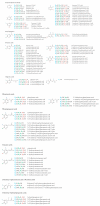Overview of Beneficial Effects of (Poly)phenol Metabolites in the Context of Neurodegenerative Diseases on Model Organisms
- PMID: 34578818
- PMCID: PMC8464690
- DOI: 10.3390/nu13092940
Overview of Beneficial Effects of (Poly)phenol Metabolites in the Context of Neurodegenerative Diseases on Model Organisms
Abstract
The rise of neurodegenerative diseases in an aging population is an increasing problem of health, social and economic consequences. Epidemiological and intervention studies have demonstrated that diets rich in (poly)phenols can have potent health benefits on cognitive decline and neurodegenerative diseases. Meanwhile, the role of gut microbiota is ever more evident in modulating the catabolism of (poly)phenols to dozens of low molecular weight (poly)phenol metabolites that have been identified in plasma and urine. These metabolites can reach circulation in higher concentrations than parent (poly)phenols and persist for longer periods of time. However, studies addressing their potential brain effects are still lacking. In this review, we will discuss different model organisms that have been used to study how low molecular weight (poly)phenol metabolites affect neuronal related mechanisms gathering critical insight on their potential to tackle the major hallmarks of neurodegeneration.
Keywords: Caenorhabditis elegans; Drosophila; Saccharomyces cerevisiae; human; microbiota; neurodegeneration; phytochemicals; rodents; zebrafish.
Conflict of interest statement
The authors declare no conflict of interest.
Figures



Similar articles
-
Main drivers of (poly)phenol effects on human health: metabolite production and/or gut microbiota-associated metabotypes?Food Funct. 2021 Nov 1;12(21):10324-10355. doi: 10.1039/d1fo02033a. Food Funct. 2021. PMID: 34558584 Review.
-
(Poly)phenol-related gut metabotypes and human health: an update.Food Funct. 2024 Mar 18;15(6):2814-2835. doi: 10.1039/d3fo04338j. Food Funct. 2024. PMID: 38414364 Review.
-
Dietary (Poly)phenols and the Gut-Brain Axis in Ageing.Nutrients. 2024 May 16;16(10):1500. doi: 10.3390/nu16101500. Nutrients. 2024. PMID: 38794738 Free PMC article. Review.
-
(Poly)phenol-gut microbiota interactions and their impact on human health.Curr Opin Clin Nutr Metab Care. 2025 Jul 1;28(4):316-322. doi: 10.1097/MCO.0000000000001132. Epub 2025 Apr 28. Curr Opin Clin Nutr Metab Care. 2025. PMID: 40293967 Free PMC article. Review.
-
Berry-Enriched Diet in Salt-Sensitive Hypertensive Rats: Metabolic Fate of (Poly)Phenols and the Role of Gut Microbiota.Nutrients. 2019 Nov 3;11(11):2634. doi: 10.3390/nu11112634. Nutrients. 2019. PMID: 31684148 Free PMC article.
Cited by
-
Natural Phenolic Compounds with Neuroprotective Effects.Neurochem Res. 2024 Feb;49(2):306-326. doi: 10.1007/s11064-023-04046-z. Epub 2023 Nov 8. Neurochem Res. 2024. PMID: 37940760 Review.
-
Polyphenolic Nano-formulations: A New Avenue against Bacterial Infection.Curr Med Chem. 2024;31(37):6154-6171. doi: 10.2174/0929867330666230607125432. Curr Med Chem. 2024. PMID: 37287289 Review.
-
Sir2 and Glycerol Underlie the Pro-Longevity Effect of Quercetin during Yeast Chronological Aging.Int J Mol Sci. 2023 Jul 31;24(15):12223. doi: 10.3390/ijms241512223. Int J Mol Sci. 2023. PMID: 37569599 Free PMC article.
-
The Crosstalk between Microbiome and Mitochondrial Homeostasis in Neurodegeneration.Cells. 2023 Jan 28;12(3):429. doi: 10.3390/cells12030429. Cells. 2023. PMID: 36766772 Free PMC article. Review.
-
Polyphenols and Their Metabolites in Renal Diseases: An Overview.Foods. 2022 Apr 6;11(7):1060. doi: 10.3390/foods11071060. Foods. 2022. PMID: 35407148 Free PMC article. Review.
References
-
- Rothwell J.A., Perez-Jimenez J., Neveu V., Medina-Remon A., M’hiri N., Garcia-Lobato P., Manach C., Knox C., Eisner R., Wishart D.S., et al. Phenol-Explorer 3.0: A major update of the Phenol-Explorer database to incorporate data on the effects of food processing on polyphenol content. Database. 2013;2013:bat070. doi: 10.1093/database/bat070. - DOI - PMC - PubMed
-
- da Silva A., Giacomoni F., Pavot B., Fillâtre Y., Rothwell J.A., Sualdea B.B., Veyrat C., Garcia-Villalba R., Gladine C., Kopec R., et al. PhytoHub V1; 4: A new release for the online database dedicated to food phytochemicals and their human metabolites. In Proceeding of the 1st International Conference on Food Bioactives and Health Conference; Norwich, UK. 13–15 September 2016; pp. 13–15.
-
- Medina-Remón A., Tresserra-Rimbau A., Pons A., Tur J.A., Martorell M., Ros E., Buil-Cosiales P., Sacanella E., Covas M.I., Corella D., et al. Effects of total dietary polyphenols on plasma nitric oxide and blood pressure in a high cardiovascular risk cohort. The PREDIMED randomized trial. Nutr. Metab. Cardiovasc. Dis. 2015;25:60–67. doi: 10.1016/j.numecd.2014.09.001. - DOI - PubMed
-
- Rodriguez-Mateos A., Vauzour D., Krueger C.G., Shanmuganayagam D., Reed J., Calani L., Mena P., Rio D.D., Crozier A. Bioavailability, bioactivity and impact on health of dietary flavonoids and related compounds: An update. Arch. Toxicol. 2014;88:1803–1853. doi: 10.1007/s00204-014-1330-7. - DOI - PubMed
Publication types
MeSH terms
Substances
Grants and funding
LinkOut - more resources
Full Text Sources
Medical
Molecular Biology Databases

